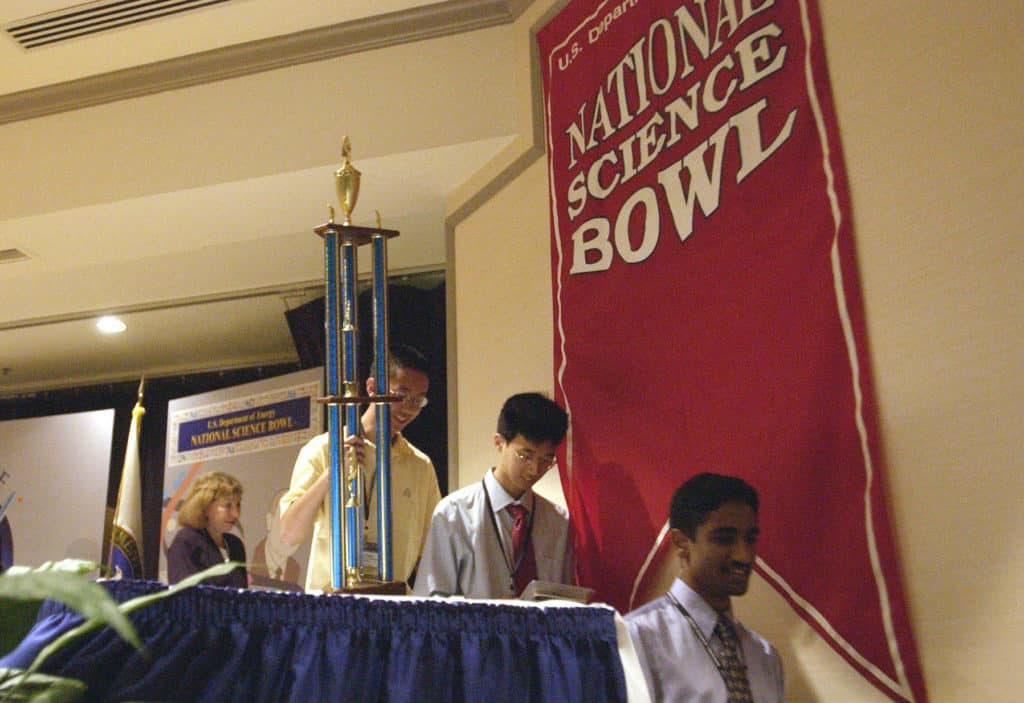Does the No. 1 High School in America Practice Discrimination?
Lisa Rab, Washingtonian, April 26, 2017

Michael Zhang, holding the trophy, Paul Yang and Sumanth Ravipati of Thomas Jefferson High School for Science & Technology win the National Science Bowl championship Competition at the National 4-H Center in Chevy Chase, Md (Credit Image: The Washington Times/ZUMAPRESS.com)
Just outside Annandale’s Koreatown, a stately dome modeled after Monticello’s stands above the entrance to the best high school in America. The 1,800 students study nanochemistry and quantum physics in labs funded by Lockheed Martin and Northrop Grumman. Seniors count NIH and Smithsonian scientists as mentors, and their average SAT scores top Fairfax County’s by 526 points. They have a planetarium and a supercomputer, and the tuition is nothing. Zero dollars. Free.
Thomas Jefferson High School for Science and Technology is a Fairfax County public magnet school so competitive that its 17-percent acceptance rate is identical to Georgetown University’s. Since 2008, Newsweek and U.S. News & World Report have both ranked it the number-one high school in the country three times. TJ enrolls students from six Northern Virginia school districts, and parents have been known to move from other cities, even countries, to ensure their children’s eligibility.
{snip}
But even as the school prepares kids to solve mind-boggling math, one challenge has flummoxed TJ since its founding: diversity. Despite being in a district that’s 19 percent Asian, 10 percent African-American, and a quarter Latino, its student body is nearly two-thirds Asian, 1.5 percent African-American, and only 2.2 percent Latino. That racial inequity has persisted for nearly 20 years. This fall, TJ will unveil a new battery of admission tests that could leave the disparity even more pronounced.
TJ was designed to be elite — founded in 1985 to educate gifted students and to help attract high-tech business to the area. Companies donated $4 million worth of equipment to get the school’s laboratories off the ground. Debate over which kids would learn in those labs quickly followed. Should TJ rely on standardized testing to decide admissions? Or should it include what one Fairfax County School Board member at the time called “human judgment”?
The year before TJ opened, a compromise was struck, shaping the process through which thousands of eighth-graders compete for 480 spots. In the first stage, applicants take an entrance exam. Their scores and GPAs determine whether they’re asked to submit essays, résumés of activities and awards, and teacher recommendations in the second round. A committee then scrutinizes the submissions for evidence of STEM (science, technology, engineering, and math) aptitude, intellectual passion, and any background or skills that will promote “diversity in the student body.” But in the first disqualifying round, decisions are numbers-driven and gender-, race-, and income-blind.
Within a few years of the school’s opening, white and Asian students made up more than 90 percent of the population.
{snip}
In 2008, U.S. News named TJ the best high school in America for the first time. Application rates shot up — more than 3,300 students applied in 2010 — while the school population shifted from majority white to majority Asian. But just beyond its woodsy campus, the Latino population was the one growing fastest.
The gap between the number of black and Latino students at TJ versus the demographics in Fairfax County schools is evidence that, intentionally or not, “the school district is practicing discrimination,” says Donna Ford, an expert on multicultural gifted education at Vanderbilt University. Her assessment is based on the “four-fifths rule,” a formula devised by the US Equal Employment Opportunity Commission. According to the rule, a school’s demographics should be within 20 percent of the district’s. For TJ, that means a student body at least 19 percent Latino and 8 percent African-American.
{snip}
The admission test is undeniably a part of the school’s persistent diversity problem. Research shows that black, Latino, and low-income students tend to score worse on standardized tests than their white and Asian counterparts. But many in Fairfax argue that the tests are the most objective way to screen students. “I think, given the high degree of rigor. . . it’s appropriate to have a standardized test as a part of the application process,” says school-board member Megan McLaughlin, a former admissions officer at Georgetown.
{snip}
Last spring, the company that makes the TJ test announced that it would no longer produce it. A committee scrambled to come up with a new process. But instead of less standardized testing, it has opted for more, adding a science section for the first time.
“Is it gonna once again advantage those kids whose parents can pay to sign them up for special prep camps to now be prepping for science testing as well?” Megan McLaughlin asked when presented with the new plan.
Admissions director Jeremy Shughart doesn’t think so. The firm that markets the math portion of the test, Quant-Q, doesn’t release materials to the public, a practice that should make them harder for test-prep schools to crack. Some board members are even hopeful the science section will boost scores for African-American, Latino, and low-income kids whose math scores aren’t as strong.
One solution still not on the table, though, is a more holistic evaluation. As board member Tamara Derenak Kaufax says, “If things don’t change with this next round of testing . . . I would definitely be willing to [speak] to my board on what we can do to make this more equitable for everyone.”















